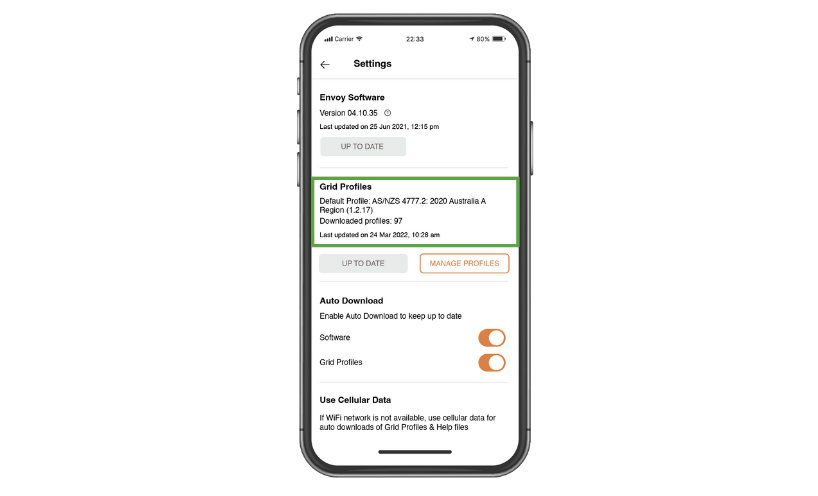Recent changes to the Australian Standards for inverters (AS/NZS4777.2) impact the commissioning process for installations now and into the future. Solar and battery inverters in Victoria and all Eastern Australia must be installed with AS/NZS 4777.2:2020 Australia A settings.
It is your legal obligation to be aware of and to comply with these new requirements. Getting inverter settings right is crucial to connecting more solar PV and battery systems, improving grid integration and maintaining stability in the grid.
How to correctly configure inverter settings
A review by the Australian Energy Market Operator found many inverters are being installed to incorrect inverter settings. To correctly configure solar PV and/or battery inverter settings in Victoria, simply:
- Select your country/region. Some manufacturers may have this pre-selected.
- Select the AS/NZS 4777.2:2020 Australia A setting. The naming of zones may differ between manufacturers but may appear as:
- Australia A – applies to the configuration of inverter settings in Victoria and all Eastern Australia (South Australia, New South Wales, ACT and Queensland).
- Australia B – applies to the configuration of inverter settings in Western Australia.
- Australia C – applies to the configuration of inverter settings in Tasmania.
In doing this, you no longer need to manually set or change different DNSP settings. If you are unsure how to select 2020 Australia A settings on the inverter, please contact the manufacturer or your DNSP to confirm the correct AS/NZS 4777.2:2020 setting.
- Turn on the device.
This image shows the critical step an installer in Victoria must take to correctly configure the inverter setting to AS/NZS 4777.2:2020 Australia A.
To commission inverter settings using the default function on your installer app:
- Go to Menu/Settings
- Check the Grid Profile is defaulted to AS/NZS 4777.2:2020: Australia A.
Note that some inverters still show legacy options in their settings menu. In Victoria, all installations must select the Australia A option.
Do not select the name of the distribution network (AusNet Services, CitiPower/ Powercor, Jemena or United Energy) in the menu.
Training on applying AS/NZS 4777.2:2020
This Clean Energy Council (CEC) course outlines how the recent changes impact your role during each solar and battery install. It is sponsored by Solar Victoria and attracts 10 elective points in the CEC Accreditation Scheme Continuous Professional Development (CPD) program.
Find this training on the CEC website.
The benefits of correctly configuring inverter settings
AS/NZS 4777.2:2020 is about improving grid integration and solar grid hosting capacity while also improving safety. All systems installed under distributor connection agreements in Victoria and all of Eastern Australia must be configured with Australia A inverter settings, prior to and post connection.
For installers in Victoria, configuring inverters to the 2020 Australia A settings will:
- Improve grid integration through refined inverter connection and disconnection thresholds and outline discrete testing procedures.
- Increase the amount of solar which can export excess electricity to the distribution grid by prescribing default (pre-set) grid support mode features, such as volt/watt, volt/var and freq/watt.
- Make it easier for industry to correctly and compliantly configure inverter settings, due to settings being prescribed as defaults.
The changes mean that solar can be relied on to perform as needed, when needed – which means more solar can continue to be installed. Interface changes also simplify commissioning.
What happens if you don't configure to the updated standard?
If your installation is identified to be non-compliant to the AS/NZS 4777.2:2020 setting requirements, you will be notified and must rectify the installation, and subsequently provide evidence of rectification. If you fail to respond, or fail to rectify, you may be suspended or lose your accreditation.
For information about audits under the Solar Homes and Solar for Business programs, including our solar battery and solar PV audit checklists, see Audits.
About the standard
AS/NZS 4777.2:2020 is the Australian Standard for inverters and applies to the grid connection of both solar PV and battery systems.
The inverter is the interface between the electricity grid and the solar and/or battery system. It manages how the system interacts with the grid, including how it behaves under different grid conditions (such as during voltage or frequency disturbances).
The behaviour of the inverter is critical for the power system as their response to system events can help to prevent cascading failure that may otherwise lead to blackouts.
Installers in Solar Victoria's programs must adhere to current and relevant standards for the design and installation of solar and battery storage systems. This is an obligation through:
- service and installation rules with your local distribution network service provider (DNSP)
- Electrical Safety Distribution Codes
- the National Electricity Rules
- the Renewable Energy Act (to be eligible for STCs and LGCs)
Complying with this updated standard became a mandatory requirement in the Solar Victoria Notice to Market, effective 18 December 2021. All new solar PV and/or battery inverters installed under Solar Victoria's rebate programs must comply with AS/NZS 4777.2:2020. These are listed in the Approved products list.
It is also a mandatory requirement of Solar Victoria's Notice to Market for inverters to be configured in accordance with DNSP requirements. To comply with these requirements, inverters must be set to the region Australia A.
Downloads
The information on this page is presented in this fact sheet:
More information
Clean Energy Council approved solar retailers and accredited installers can access this toolbox talk: Watch the CEC webinar (duration: 6 minutes). Note: you need a subscription to access this resource.
Please also see the Smart Energy Council webinar held on 14 April 2022 (duration: 1 hour 3 minutes). This resource is available to all.
Australian Standards, including AS/NZS 4777.2:2020, can be purchased from various sites, including:
Updated




